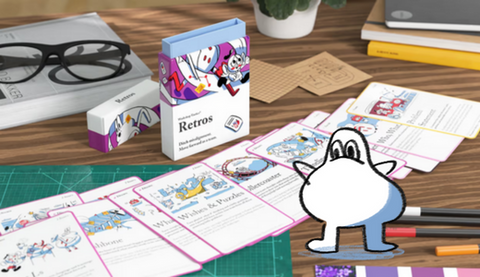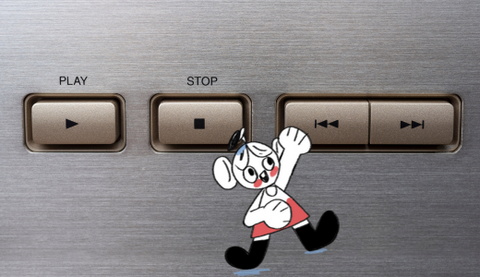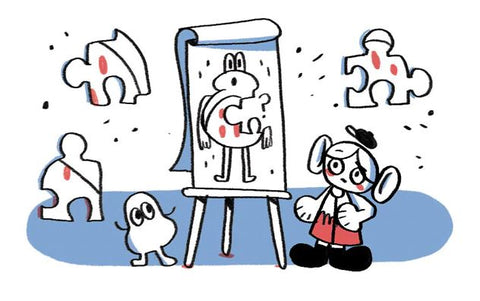ℹ️ Skip to key parts of the session by clicking on the chapter dots along the timeline.
This fantastic session is led by Anamaria Dorgo from Butter, and Rachel Davis, an expert facilitator (who also has a special interest in Miro). While focussing on using Butter itself, this session is packed with great examples and tips for inspiring engagement in virtual meetings, and especially those using Miro too.
The session kicked off with the following prompt:
Draw together: what does engagement look like to you?

A quick reactions-poll at the start showed that around 50% of participants have used Butter before, while the other half are completely new to it. A slightly more detailed poll later on shows that most of them actually consider themselves to be closer to “little babies, learning to crawl” with Butter than they are to “Butter ninjas”, so they’re in the right place!
The Secret to Legendary Virtual Collaboration: Butter
Butter is a virtual collaboration tool that allows you to plan and host fun workshops. This is a great session for new users as it shows off tonnes of features and tools. Right from the start, you get to see how you can use Gifs to do a quick ‘temperature check’, plus you’ll notice a progress bar at the top-left of the screen, showing how far through each session you are. And there are some fun sound effects, too!
Interested in Butter? You can get 30% off the first three months, using the code PIPDECKS30 (more details here).
Behind the scenes
Anamaria gives you a behind-the-scenes look at her facilitator view, so you can see how she has set up the extended agenda and how to choose and manage music, for example to use during a ten-minute activity.
You also get a sneak peek at setting up polls, which you can do in advance (and have a surprising number of useful settings!).
Hopes and Fears
The next section is a beautiful Miro board (courtesy of Rachel) of the Hopes and Fears workshop tactic.

Anamaria explains how participants can use sticky dots and notes to show what they are hoping to get out of the session, and the fears and worries they may have about the session.
Lots of little knowledge drops during this session:
- There’s an “I’m done” feature, so you can see if your participants have all finished early.
- Miro boards don’t work on the mobile app version of Butter.
- You can hide the cursors/names if you want to.
- ‘Bring everyone to me’ is a great tool for facilitators whose attendees have spread out too far across the Miro board.
- There’s an “I have a comment” button if you’d like to raise your hand instead of jumping in on the mic (or if you're muted).
- There’s a Butter referral link! And a discount for the Pip Decks community. And a referral scheme, so you get credits if you share it with others.
- Soundboards are fun, but don’t enable them from the start for everyone as they are likely to get overused.
Great tip for freelancers: if you offer a package of work that requires the use of tools like Butter, then bake the cost of the platform into those packages! Don’t get caught paying for the tools out of your own pocket if they are for the benefit of your customers.
Someone asked what the difference is between Miro and Butter. It's worth noting this down - if you introduce both tools at the same time, you might get the same question!
- Miro in one sentence: a visual collaboration whiteboard for creating experiences/workshops that gets everyone involved on screen.
- Butter in one sentence: a virtual communication platform where people can communicate using video, voice and other engagement tools and you can design beautiful learning experiences.
Skip to the Miro behind the scenes chapter of the video to get a tour of the facilitator toolbars and some Miro lingo, including frames and how to export the various notes participants have made during a session.
Starburst brainstorming: what does it take to be a great facilitator?
Rachel showed a super easy way to get everyone thinking and sharing ideas about what makes a great facilitator using a starburst brainstorm.

This gives you nicely ‘theme sorted’ outputs as each section of the starburst asks for a different category. So, what tools, mindsets, techniques, processes and skillsets do great facilitators need? Watch from the Brainstorm discussion chapter in the video to find out.
Top tips?
- On screen, you need 30% more energy than when you’re facilitating in person (but do match your energy to your audience/topic).
- Use emojis! They’re great for people who struggle to find words quickly, are worried about spelling or are using a second language.
- Get comfortable with silence as a facilitator. It means people are listening/thinking. It also helps you to be inclusive to different personality types. Rachel: “The longer you wait, the better the answer”.
- Anonymous open-ended polls are great for people who don’t feel comfortable sharing things. For example, if there is a CEO in the room, or people are worried about being singled out for having a different viewpoint.
Divergent and convergent activities
The brainstorming session is a great example of a divergent activity that looks to get everyone generating a wide range of ideas. After divergent exercises, you’d usually follow with a convergent activity that helps you to sort all of the ideas and choose one or more to focus on. This session fast-forwards past that bit, conveniently landing on one single tool that all great facilitators need: Butter!
SWOT analysis (and breakout rooms!)
The next step is to run a SWOT analysis of Butter as a path to becoming a more engaging facilitator. This section of the session shows you how to manage breakout rooms and get participants working in small groups on different sections of the Miro board.

You’ll get a behind the scenes look at setting up those breakout rooms - look for the Breakout ends chapter.
Check out activity (flashcards)
There comes a point in every workshop where you just have to ask:
Where are you, on a scale of 0 - GOAT?
Here you’ll see an interactive flashcard in use - great for emotional wheels, or to see where everyone is distributed around the world. The possibilities are endless! It’s also nice and easy to use, without using Miro if you want a low-tech experience.
Q&As
How did you come up with the name Butter?
Because it makes virtual meetings run smoothly, like butter!
How to introduce Butter to new users/organisations?
If you're working with people who haven't used Butter before and may be a little apprehensive about it, you can start to introduce it during normal, short, one-on-one calls. That will help to take the pressure off. And you can record a short Loom video of yourself using the platform and send it to attendees ahead of a workshop if you want to show them around a bit beforehand, too.
Thanks to Anamaria and Rachel for taking the time to share their expertise and experience with the rest of the Pip Decks community.









